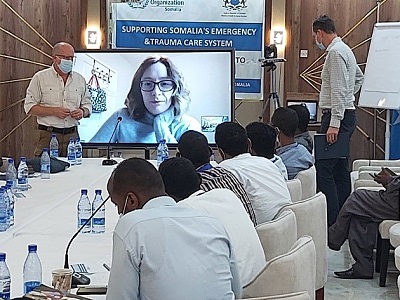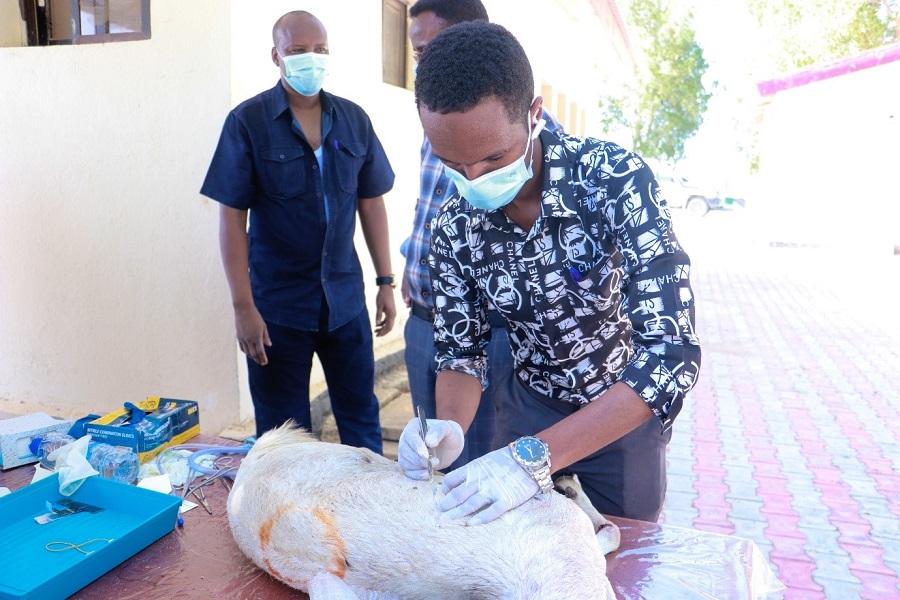11 November 2021 – In the last 3 decades, Somalia has faced protracted conflict and emergencies — as a result of which the high burden of injuries has been ubiquitous and often poorly addressed from the public health lens.
The public health burden of injuries and trauma
In December 2020 and January 2021, the Federal Ministry of Health, with technical support from World Health Organization (WHO), conducted a rapid assessment of critical care services in 136 hospitals across 18 regions and focus group discussions with frontline health care workers in Somalia. This was supported by the World Bank under its Pandemic Emergency Financing Facility to improve access to health services in Somalia.
The assessment revealed that trauma imposes a heavy burden on the Somali health system and the community at large. The hospitals had recorded more than 37 000 civilian trauma cases over 12 months. Yet, the survey referred to cases of conflict alone. If it had included road traffic accidents, domestic injuries and burns, or covered small peripheral hospitals and primary health care centres, the number of civilian trauma cases recorded would have been even higher. The Global Burden of Disease Study published in 2019 by the Institute for Health Metrics and Evaluation, Seattle, shows that the share of the disability burden of injuries increased from 6.23% in 2000 (age-standardized rate: 5617.28 disability-adjusted life years (DALYs) lost per 100 000 population) to 8.60% (age-standardized rate: 5739.72 DALYs lost per 100 000 population) in 2019. These figures are projected to increase to 6300.88 age-standardized DALYs per 100 000 population and 6.49% of DALYs lost in Somalia in 2030. The substantial increase in conflict and terror as well as the increased burden of road injuries observed between 2000 and 2019 were the main factors driving the upward trend in injury-related deaths and disability in Somalia. The study also showed that deaths caused by injuries were estimated to be 119.10 per 100 000 population in Somalia in 2019, and injuries were responsible for an estimated 7.35% of all deaths reported in the country.
Injuries and trauma pose a double threat to affected communities. In addition to the physical burden caused by injuries, trauma is also known to have a negative effect on the socioeconomic environment in a country. By this measure, it increases poverty levels, as families of the injured need to spend substantive time, money and efforts caring for their loved ones.
The capacity of the existing system
In Somalia, there is a scarcity of health personnel. For example, there are no paediatric trauma specialists and no recognized medical anaesthetists working in the public sector. Half of the hospitals surveyed functioned with only one or 2 general surgeons and only 5 hospitals claimed to have surgeons with a background in orthopaedic surgery.
There is currently no effective pre-hospital system beyond central Mogadishu; and communities in rural and remote areas have little or no access to trauma care. In the wider picture, this includes maternity services and women die needlessly for want of basic prehospital care.
“It is an undeniable paradox that in recent times those most in need of trauma care services are the least able to access those services. As one of the few UN agencies working in this field, WHO has stepped up to provide technical assistance and coordinate the trauma care response in the country,” said Dr Mamunur Rahman Malik, WHO Representative to Somalia. “This support is largely being steered by the Government of Somalia, and we are working closely with hospitals and personnel to make advances in this field.”
Establishing a WHO trauma programme for Somalia
The WHO country office for Somalia, with support from the WHO Regional Office for the Eastern Mediterranean, is setting up a trauma care programme that is built on the vision of a holistic approach to trauma, from the point of injury, when one is injured, through surgery to the physical rehabilitation of the patient, back into the community.
As part of this initiative, the WHO delivered the first Surgical Team Approach to Trauma (STAT) course, using high technology surgical simulation facilities and virtual reality. Overall, 31 health workers were trained, bringing together surgeons and anaesthetists to embed a team-based approach to trauma management. The training took place from 3 to 7 October in Mogadishu and 11 to 15 October 2021 in Berbera. Trainees were exposed to high fidelity scenarios in an operating theatre, all while observing strict COVID-19 protocols and minimizing the spread of infection. They also learnt how to use ultrasound at the point of care and in emergency departments.
As an anaesthetist working at the Baidoa Medical Hospital, Dr Abdirahman Mohamed Hassan shared his reflections:
 Trainees were able to watch live how a trauma teams works in other contexts, including the UK“After the training, I realized the value of working together as a team in my hospital. Now, we have started to share all the knowledge we have and experiences we go through, both in person and on group chats, and it feels really good for all of us, as we are learning best practices together every day. I can already see that this has better outcomes for our patients. Before this, there was no groupwork or teamwork – we all worked on our own,” Dr Hassan said.
Trainees were able to watch live how a trauma teams works in other contexts, including the UK“After the training, I realized the value of working together as a team in my hospital. Now, we have started to share all the knowledge we have and experiences we go through, both in person and on group chats, and it feels really good for all of us, as we are learning best practices together every day. I can already see that this has better outcomes for our patients. Before this, there was no groupwork or teamwork – we all worked on our own,” Dr Hassan said.
Two other crucial lessons Dr Hassan learnt is that anaesthesia can be administered on patients even if they aren’t fasting, as previously, he believed he had to wait until the patient had been on an empty stomach for a while, which caused unnecessary delays in fragile situations. Dr Hassan also learnt that anaesthetists play a key and active role in responding to trauma patients, and that their role is not limited to addressing patients before and during the surgeries.
“Last week, a 35-year-old man who was involved in a car crash outside Baidoa was rushed to the hospital. He was bleeding profusely around his pelvic area. I took over the situation as a team lead. I assessed the case, compressed the wound, checked the patient’s airway, offered intubation, and rehydrated him. I worked swiftly with the teams in the emergency ward and operating theatre, and, of course, also checked on the patient before, during and after the surgery,” said Dr Hassan. “I was so confident in my response to him, thanks to this training by WHO.”
Using creative and effective ways to create an impact
Both the Ministry of Health and WHO also arranged for trainees to work in simulated situations in high-quality operating theatres. By way of this initiative, they learnt how to maintain hygiene and wear their protective equipment to reduce the spread of infections.
The trainers also lent the participants modern, virtual headsets for them to use to test their knowledge, by experiencing different virtual reality scenarios. Trainers used these creative and highly effective methods of imparting knowledge in addition to presentations and theory.
Dr Sara Halimah, WHO Regional Trauma Specialist, explained that the trauma programme attempts to provide a stepwise, practical, and realistic approach to the management of victims of trauma.
“Although the acute humanitarian needs of Somalia are at the heart of this initiative, it recognises that a long-term problem necessitates a long-term solution, and that humanitarian and development efforts must be aligned to build a trauma care system that not only responds to today’s humanitarian needs but also developing a system that will serve the future needs of Somalia to reduce the high burden of injuries as a public health problem in the country,” Dr Halimah added.
 Through the training, health professionals worked with animal carcasses to learn how to address bullet wounds
Through the training, health professionals worked with animal carcasses to learn how to address bullet wounds
Building on what has been achieved with support from the World Bank‘s funding from Pandemic Emergency Financing Facility in January-March 2021 and capitalizing on this new initiative on “Surgical Team Approach to Trauma (STAT),” the WHO country office will work with the federal and state ministries of health to set up a trauma care system as part of emergency, critical and operative care services in the country, as part of Somalia’s overarching goal of achieving universal health coverage, leaving no one behind.


